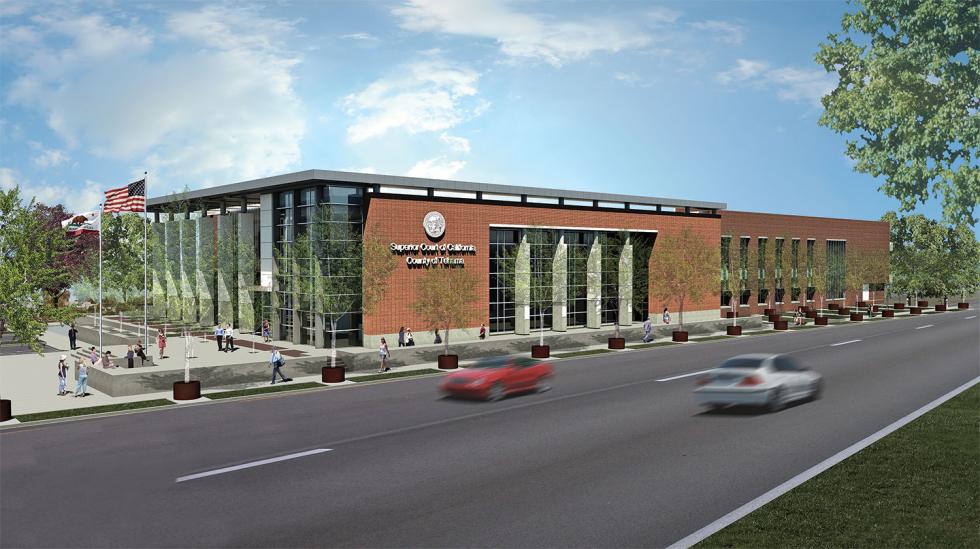In a few years, a brand new criminal courthouse is expected to open on the edge of the Sacramento railyards. Located on the corner of H and 6th streets, this second Sacramento County court building will be 405,500 square feet with 44 courtrooms. And it’s not the only new courthouse on the horizon. Right now, there are about 100 courthouses identified for development in California.
Before 2002, counties handled the construction and maintenance of these buildings, but that oversight shifted. The Trial Court Facilities Act made the Judicial Council of California — the policymaking body for the California court system — responsible for all court facilities statewide, enabling a single, comprehensive infrastructure program for the construction and maintenance of California’s courthouses, says Keby Boyer, a communications specialist with the council.
“Because of the severity of the recession, individual counties often struggled with the expense of maintaining county-owned buildings, including the courthouses,” Boyer says.
With so many courthouses in the pipeline, it remains to be seen if private design and construction teams can handle the pressure. Here’s a roundup of the key projects-in-progress:
New Sacramento Criminal Courthouse
Location: Sacramento County
Funding: The project is funded by Senate Bill 1407. The initial funding year was fiscal year 2009-2010 (current authorized budget through working drawings is $49 million).
Progress level: Architectural design, preliminary plans.
Expected completion date: TBD. The Judicial Council indefinitely delayed the new Sacramento Criminal Courthouse project due to the state’s fiscal crisis and continuing cuts in court construction funds, Boyer says. The legislation for $27 million for the project’s architectural design was approved last September. Architectural design will proceed. However, funds for construction of this project have yet to be legislated. If construction funding is not secured, the Sacramento project will again be delayed.
New Stockton Courthouse
Location: San Joaquin County
Funding: Trial Court Facilities Act of 2002, through trial court user fees. The current authorized project budget is $273 million.
Progress level: Under construction.
Expected completion date: End of 2016.
New Red Bluff Courthouse
Location: Tehama County
Funding: Funded through Senate Bill 1407. The initial funding year was fiscal year 2009-2010. The current authorized project budget is $56 million.
Progress level: Under construction.
Estimated completion date: Fall 2016.
Red Bluff Courthouse: courtesy of LPAS

According to Curtis Owyang, the project design architect and LPAS vice president: “A modern, energy-efficient building, the design takes its inspiration from the historic courthouse that has served this region since 1920. The 62,000-square-foot new courthouse will provide five courtrooms and other court services. Because of the state’s budget crisis, this project was designated as a cost-reduction demonstration project. The design team identified several ways to reduce construction costs, and these were incorporated into the design. These strategies include using modified tilt-up concrete construction, eliminating a basement level and employing commercial-grade finishes.”
New Yuba City Courthouse
Location: Sutter County
Funding: Funded through Senate Bill 1407. The initial funding year fiscal year 2009-2010. The current authorized project budget is $66 million.
Progress level: Under construction.
Expected completion date: Summer 2015.
New Woodland Courthouse
Location: Yolo County
Funding: Funded by Senate Bill 1407. The initial funding year was fiscal year 2009-2010. The current authorized project budget is $161 million.
Progress level: Complete.
According to Presiding Judge Kathleen M. White at the Superior Court of Yolo County: “A courthouse is built perhaps once every four generations. The judges, court and state judicial council staff and local leaders who have collaborated in this great effort understand that this building must serve today’s needs and the needs of our children, grandchildren and great grandchildren. It’s not enough that it be functional, cost effective, energy efficient and secure. It must also demonstrate to future generations how much we value justice. I think we succeeded.”
For information and status updates on California’s courthouse projects, visit courts.ca.gov.
For more on the state of construction, check back next week
for Russell Nichols September feature, “Pushed to the Limit.” Or sign up for our newsletter
and we’ll email you when it’s available online.



